#A NEOLITHIC MARBLE FEMALE FIGURE
Text
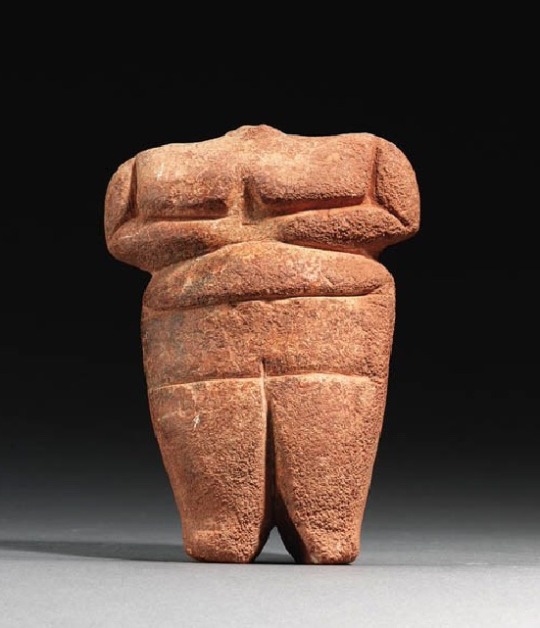
A NEOLITHIC MARBLE FEMALE FIGURE
THESSALY, CIRCA 4500-4000 B.C.
The corpulent figure with her arms crossed below her breasts, the bulging midrift offset from the flattened waist by an incised groove, standing with her feet apart, her legs divided by a deep cleft.
5 in. (14.6 cm) high
#A NEOLITHIC MARBLE FEMALE FIGURE#CIRCA 4500-4000 B.C.#marble#marble statue#marble sculpture#ancient greek sculpture#ancient artifacts#archeology#archeolgst#history#history news#ancient history#ancient culture#ancient civilizations#ancient greece#greek history#greek art
126 notes
·
View notes
Note
Can you make a post about the evolution of Greek art from the ancient times until now in modern age?
Because we often talk about the evolution of art but unfortunately we don't appreciate after ancient times the other art movements Greece went through the centuries.
That’s true! I am sorry for taking ages to answer this but I don't know how it could take me less anyway hahaha I made this post with summaries about all artistic eras in Greek history. I have most of it under a cut because with the addition of pictures it got super long, but if you are interested in the history of art I recommend giving it a try! I took advantage of all 30 pictures that can be possibly attached in a tumblr post and I tried to cover as many eras and art styles as possible, nearly dying in the process ngl XD I dedicated a few more pictures in modern art, a) because that was the ask and b) because there is more diversity in the styles that are used and the works that are available to us in great condition in modern times.
History of Greek Art
Greek Neolithic Art (c. 7000 - 3200 BC)
Obviously, with this term we don’t mean there were people identifying as Greeks in Neolithic times, but it defines the Neolithic art corresponding to the Greek territory. Art in this era is mostly functional, there are progressively more and more defined designs on clay pots, tools and other utility items. Clay and obsidian are the most used materials.
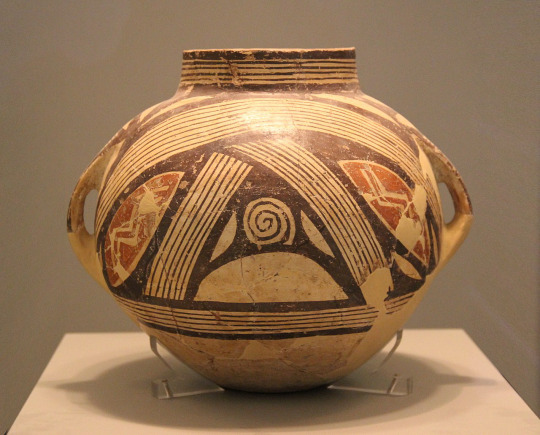
Clay vase with polychrome decoration, Dimini, Magnesia, Late or Final Neolithic (5300-3300 BC).
Cycladic Art (3300 - 1100 BC)
The art of the Cycladic civilisation of the Aegean Islands is characterized by the use of local marble for the creation of sculptures, idols and figurines which were often associated to womanhood and female deities. Cycladic art has a unique way of incidentally feeling very relevant, as it resembles modern minimalism.

Early Cycladic II (Keros-Syros culture, 2800–2300 BC)
Minoan Art (3000-1100 BC)
The advanced Minoan civilisation of Crete island was projecting its confidence and its vibrancy through its various arts. Minoan art was influenced by the earlier Egyptian and Near East cultures nearby and at its peak it overshadowed the rest of the contemporary cultures and their artistic movements in Greece. Colourful, with numerous scenes of everyday life and island life next to the sea, it was telling of the society’s prosperity.

The Bull-leaping fresco from Knossos, 1450 BC.
Mycenaean Art (c. 1750 - 1050 BC)
Mycenaean Art was very influenced by Minoan Art. Mycenaean art diverged and distinguished itself more in warcraft, metalwork, pottery and the use of gold. Even when similar, you can tell them apart from their themes, as Mycenaean art was significantly more war-centric.
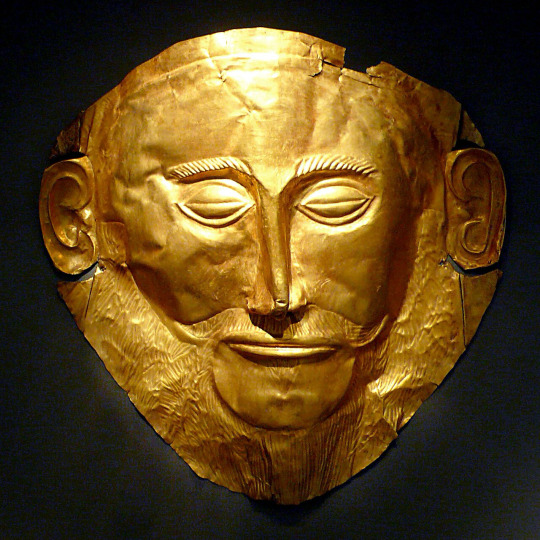
The Mask of Agamemnon in the National Archaeological Museum of Athens. The mask likely was crafted around 1550 BC so it predates the time Agamemnon perhaps lived.
Geometric Art (1100 - 700 BC)
Corresponding to a period we have comparatively too little data about, the Geometric Period or the Homeric Age or the Greek Dark Ages, geometric art was characterized by the extensive use of geometric motifs in ceramics and vessels. During the late period, the art becomes narrative and starts featuring humans, animals and scenes meant to be interpreted by the viewer.

Detail from Geometric Krater from Dipylon Cemetery, Athens c. 750 BC Height 4 feet (Metropolitan Museum, New York)
Archaic Art (c. 800 - 480 BC)
The art of the archaic period became more naturalistic and representational. With eastern influences, it diverged from the geometric patterns and started developing more the black-figure technique and later the red-figure technique. This is also the earliest era of monumental sculpture.
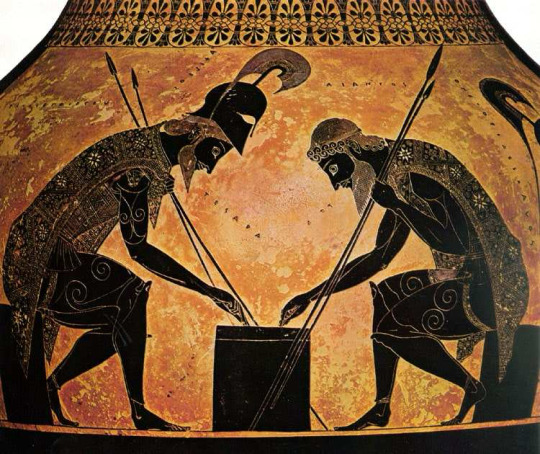
Achilles and Ajax Playing a Board Game by Exekias, black-figure, ca. 540 B.C.
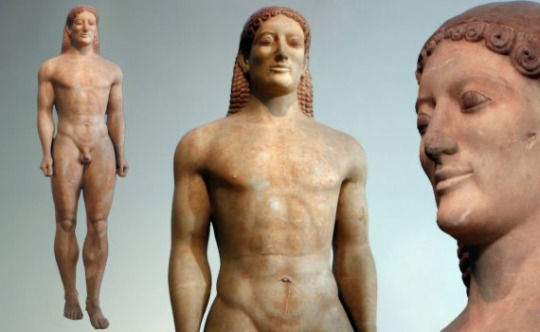
Kroisos Kouros, c. 530 B.C.
Classical Art (c. 480 - 323 BC)
Art in this era obtained a vitality and a sense of harmony. There is tremendous progress in portraying the human body. Red-figure technique definitively overshadows the use of the black-figure technique. Sculptures are notable for their naturalistic design and their grandeur.
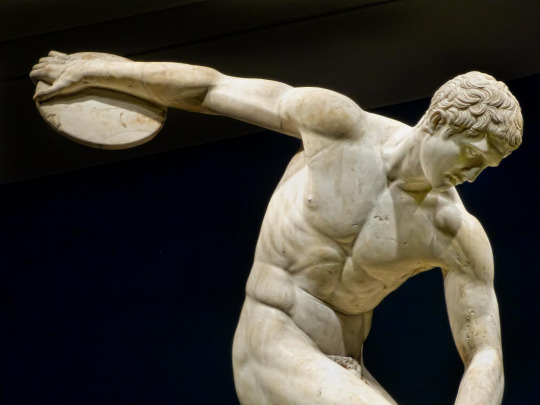
The Diskobolos or Discus Thrower, Roman copy of a 450-440 BCE Greek bronze by Myron recovered from Emperor Hadrian’s Villa in Tivoli, Italy. (British Museum, London). Photo by Mary Harrsch.

Terracotta bell-krater, Orpheus among the Thracians, ca. 440 BCE, The Metropolitan Museum of Art.
Hellenistic Art (323 - 30 BCE)
Hellenistic art perfects classical art and adds more diversity and nuance to it, something that can be explained by the rapid geographical expansion of Greek influence through Alexander’s conquests. Sculpture, painting and architecture thrived whereas there is a decrease in vase painting. The Corinthian style starts getting popular. Sculpture becomes even more naturalistic and expresses emotion, suffering, old age and various other states of the human condition. Statues become more complex and extravagant. Everyday people start getting portrayed in art and sculpture without extreme beauty standards imposed. We know there was a huge rise in wall painting, landscape art, panel painting and mosaics.

Mosaic from Thmuis, Egypt, created by the Ancient Greek artist Sophilos (signature) in about 200 BC, now in the Greco-Roman Museum in Alexandria, Egypt. The woman depicted in the mosaic is the Ptolemaic Queen Berenike II (who ruled jointly with her husband Ptolemy III) as the personification of Alexandria.

Agesander, Athenodore and Polydore: Laocoön and His Sons, 1st century BC
Greco-Roman Art (30 BC - 330 AD)
This period is characterized by the almost entire and mutually influential merging of Greek and Roman artistic expression, in light of the Roman conquest of the Hellenistic world. For this era, it is hard to find sources exclusively for Greek art, as often even art crafted by Greeks of the Roman Empire is described as Roman. In general, Greco-Roman art reinforces the new elements of Hellenistic art, however towards the end of the era, with the rise of early Christianity in the Eastern aka the Greek-influenced part of the empire, there are some gradual shifts in the art style towards modesty and spirituality that will in time lead to the Byzantine art. During this era mosaics become more loved than ever.
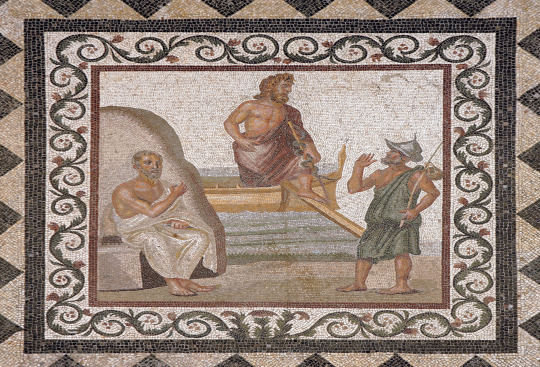
A mosaic from the island of Kos (the birthplace of Hippocrates) depicting Hippocrates (seated) and a fisherman greeting the god Asklepios (center) as he either arrives or disembarks from the island. Second or third century CE.
Introduction to Byzantine Art
Byzantine art originated and evolved from the now Christian Greek culture of the Eastern Roman Empire. Although the art produced in the Byzantine Empire was marked by periodic revivals of a classical aesthetic, it was above all marked by the development of a new aesthetic defined by its salient "abstract", or anti-naturalistic character. If classical art was marked by the attempt to create representations that mimicked reality as closely as possible, Byzantine art seems to have abandoned this attempt in favor of a more symbolic approach. The subject matter of monumental Byzantine art was primarily religious and imperial: the two themes are often combined.
Early Byzantine Art (330 - 842 AD)
The establishment of the Christian religion results in a new artistic movement, centered around the faith. However, ancient statuary remains appreciated. Most fundamental changes happen in monumental architecture, the illustration of manuscripts, ivory carving and silverwork. Exceptional mosaics become integral in artistic expression. The last 100 years of this period are defined by the Iconoclasm, which temporarily restricts entirely the previously thriving figural religious art.

Mosaics in the Rotunda of Thessaloniki, 4th - 6th century AD.
Macedonian Art & Komnenian Age (843 - 1204 AD)
These artistic periods correspond to the middle Byzantine period. After the end of the Iconoclasm, there is a revival in the arts. The art of this period is frequently called Macedonian art, because it occurred during the Macedonian imperial dynasty which generally brought a lot of prosperity in the empire. There was a revival of interest in the depiction of subjects from classical Greek mythology and in the use of Hellenistic styles to depict religious subjects. The Macedonian period also saw a revival of the late antique technique of ivory carving. The following Komnenian dynasty were great patrons of the arts, and with their support Byzantine artists continued to move in the direction of greater humanism and emotion. Ivory sculpture and other expensive mediums of art gradually gave way to frescoes and icons, which for the first time gained widespread popularity across the Empire. Apart from painted icons, there were other varieties - notably the mosaic and ceramic ones.
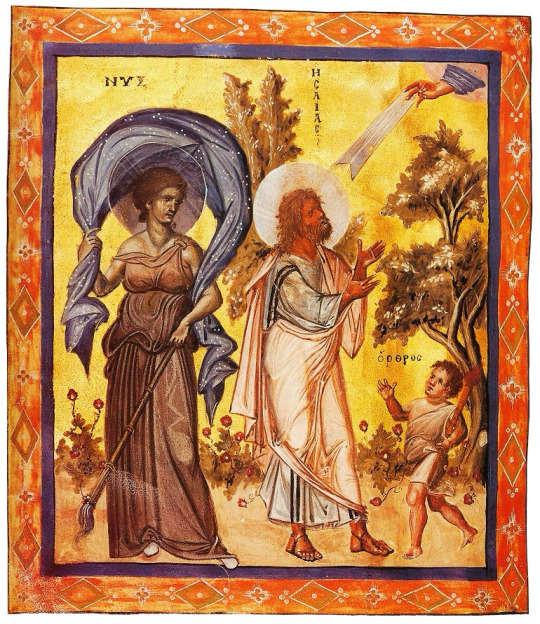
Paris Psalter, 10th century AD. Prophet Isaiah from the Old Testament in the company of the symbolisms for night (clear inspiration drawn from the ancient deity Nyx) and morning (Orthros, not to be confused with the mythological creature).
Palaeologan Renaissance (1261 - 1453)
The Palaeologan Renaissance is the final period in the development of Byzantine art. Coinciding with the reign of the Palaeologi, the last dynasty to rule the Byzantine Empire (1261–1453), it was an attempt to restore Byzantine self-confidence and cultural prestige after the empire had endured a long period of foreign occupation. The legacy of this era is observable both in Greek culture after the empire's fall and in the Italian Renaissance. Contemporary trends in church painting favored intricate narrative cycles, both in fresco and in sequences of icons. The word "icon" became increasingly associated with wooden panel painting, which became more frequent and diverse than fresco and mosaics. Small icons were also made in quantity, most often as private devotional objects.
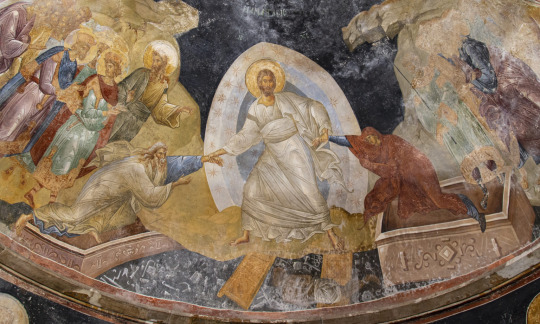
Detail of Anástasis (Resurrection) fresco, c. 1316–1321, Chora church, Constantinople (Istanbul) (photo: byzantologist).
Cretan School (15th - 17th century)
Cretan School describes an important school of icon painting, under the umbrella of post-Byzantine art, which flourished while Crete was under Venetian rule during the Late Middle Ages, reaching its climax after the Fall of Constantinople, becoming the central force in Greek painting during the 15th, 16th and 17th centuries. By the late 15th century, Cretan artists had established a distinct icon-painting style, distinguished by "the precise outlines, the modelling of the flesh with dark brown underpaint, the bright colours in the garments, the geometrical treatment of the drapery and, finally, the balanced articulation of the composition". Contemporary documents refer to two styles in painting: the maniera greca (in line with the Byzantine idiom) and the maniera latina (in accordance with Western techniques), which artists knew and utilized according to the circumstances. Sometimes both styles could be found in the same icon. The most famous product of the school was the painter Domenikos Theotokopoulos, internationally known as El Greco, whose art evolved and diverged significantly in his later years when he moved in Spain and was involved in the Spanish Renaissance, and though it often alienated his western contemporary artists, nowadays it is viewed as an incidental early birth of Impressionism in the mid of the Renaissance’s peak.

Icon by Andreas Pavias (1440-1510), Cretan School, from Candia (Venetian Kingdom of Crete). The Latin inscription suggests the icon was meant for commercial purposes in Western Europe. National Museum, Athens. (Source: https://russianicons.wordpress.com/tag/cretan-school/)

Crucifixion (detail), El Greco (Doménikos Theotokópoulos), ca. 1604 - 1614.
Heptanesian School (17th - 19th century)
The Heptanesian school succeeded the Cretan School as the leading school of Greek post-Byzantine painting after Crete fell to the Ottomans in 1669. Like the Cretan school, it combined Byzantine traditions with an increasing Western European artistic influence and also saw the first significant depiction of secular subjects. The center of Greek art migrated urgently to the Heptanese (Ionian) islands but countless Greek artists were influenced by the school including the ones living throughout the Greek communities in the Ottoman Empire and elsewhere in the world. Greek art was no longer limited to the traditional maniera greca dominant in the Cretan School. Furthermore, the Heptanesian school was the basis for the emergence of new artistic movements such as the Greek Rocco and Greek Neoclassicism. The movement featured a mixture of brilliant artists.

Archangel Michael, Panagiotis Doxaras, 18th century.
Greek Romanticism (19th century)
Modern Greek art, after the establishment of the Greek Kingdom, began to be developed around the time of Romanticism. Greek artists absorbed many elements from their European colleagues, resulting in the culmination of the distinctive style of Greek Romantic art, inspired by revolutionary ideals as well as the country's geography and history.

Vryzakis Theodoros, The Exodus from Missolonghi, 1853. National Gallery, Athens.
The Munich School (19th century Academic Realism)
After centuries of Ottoman rule, few opportunities for an education in the arts existed in the newly independent Greece, so studying abroad was imperative for artists. The most important artistic movement of Greek art in the 19th century was academic realism, often called in Greece "the Munich School" because of the strong influence from the Royal Academy of Fine Arts of Munich where many Greek artists trained. In academic realism the imperative is the ethography, the representation of urban and/or rural life with a special attention in the depiction of architectural elements, the traditional cloth and the various objects. Munich School painters were specialized on portraiture, landscape painting and still life. The Munich school is characterized by a naturalistic style and dark chiaroscuro. Meanwhile, at the time we observe the emergence of Greek neoclassicism and naturalism in sculpture.

Nikolaos Gyzis, Learning by heart, 1883.
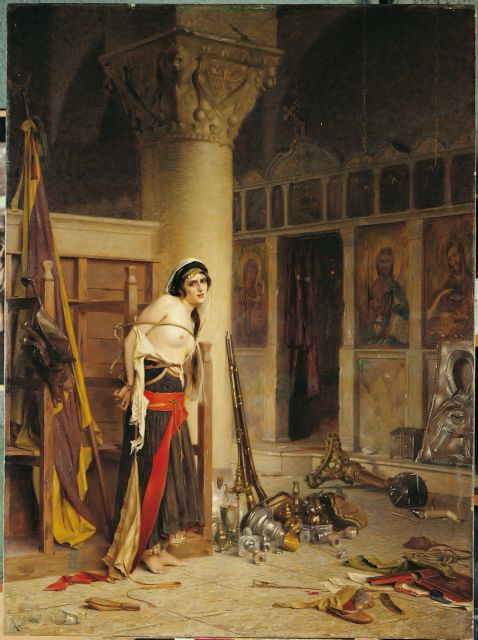
Rallis Theodoros, The Booty, before 1906.
20th Century Modern & Contemporary Greek Art
At the beginning of the 20th century the interest of painters turned toward the study of light and color. Gradually the impressionists and other modern schools increased their influence. The interest of Greek painters, artists changes from historical representations to Greek landscapes with an emphasis on light and colours so abundant in Greece. Representatives of this artistic change introduce historical, religious and mythological elements that allow the classification of Greek painting into modern art. The era of the 1930s was a landmark for the Greek painters. The second half of the 20th century has seen a range of acclaimed Greek artists too serving the movements of surrealism, metaphysical art, kinetic art, Arte Povera, abstract excessionism and kinetic sculpture.
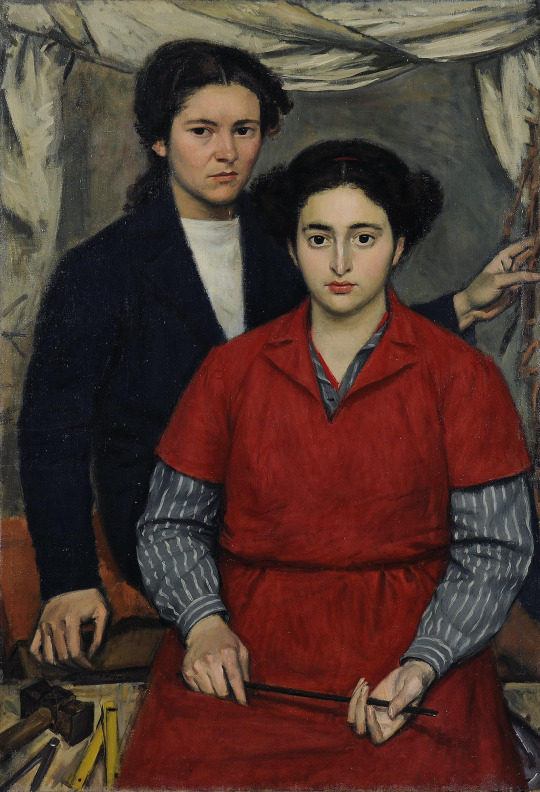
Yiannis Moralis, Two friends, 1946.
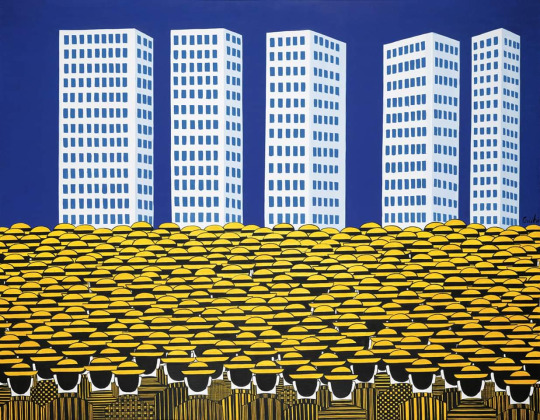
Art by Giannis Gaitis (1923-1984), famous for his uniformed little men.

By Yorghos Stathopoulos (1944 - )
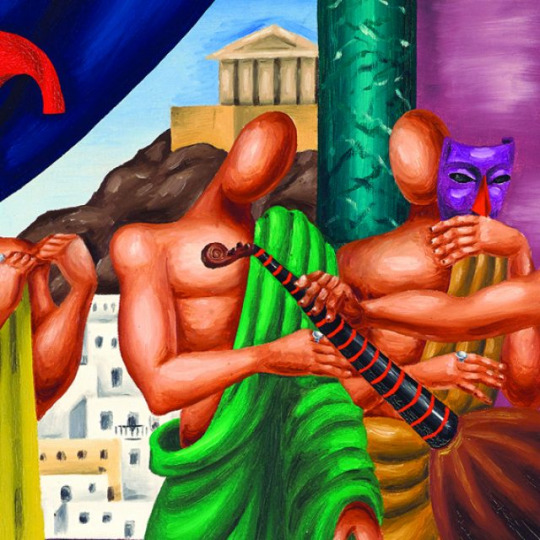
Art (detail) by Nikos Engonopoulos (1907 - 1985)
Folk, Modern Ecclesiastical and Secular Post-Byzantine Art
Ecclesiastical art, church architecture, holy painting and hymnology follow the order of Greek Byzantine tradition intact. Byzantine influence also remained pivotal in folk and secular art and it currently seems to enjoy a rise in national and international interest about it.

A modern depiction of the legendary hero Digenes Akritas depicted in the style of a Byzantine icon by Greek artist Dimitrios Skourtelis. Credit: Dimitrios Skourtelis / Reddit

Erotokritos and Aretousa by folk artist Theophilos (1870-1934)

Example of Modern Greek Orthodox murals, Church of St. Nicholas.

Ancient Greek philosophers depicted in iconographic fashion in one of Meteora’s monasteries. Each is holding a quote from his work that seems to foreshadow Christ. Shown from left to right are: Homer, Thucydides, Aristotle, Plato and Plutarch. This is not as weird as it may initially seem: it was a recurrent belief throughout the history of Christian Greek Orthodoxy that the great philosophers of the world heralded Jesus' birth in their writings - it was part of the eras of biggest reconciliation between Greek Byzantinism and Classicism.

Prophet Elijah icon with Chariot of Fire, Handmade Greek Orthodox icon, unknown iconographer. Source
If you see this, thanks very much for reading this post. Hope you enjoyed!
#greece#art#europe#history#culture#greek art#artists#greek culture#history of art#classical art#ancient greek art#byzantine greek art#christian art#orthodox art#modern art#modern greek art#anon#ask
63 notes
·
View notes
Photo





Cycladic Marble Female Figures made in the late neolithic from the Met’s collection
127 notes
·
View notes
Photo



Archaeologists in Turkey Find Neolithic Female Statuette Intact
The Neolithic site of Çatalhöyük, Turkey, consists of two settlement mounds — the remains of houses continually built over old ones — that have yielded many treasures since archaeologists began excavations in the 1960s. One of the most remarkable artifacts to emerge recently is a slightly weathered but fully intact, female anthropomorphic figure carved of marble — a rare find at the UNESCO World Heritage Site that illustrates one ancient craftsperson’s great level of skill. Archaeologists with the Çatalhöyük Research Project, which has explored the site since 1993, found it this summer in one of the site’s earliest structures; they estimates it dates to about 5500–8000 BCE.
> hyperallergic.com
4K notes
·
View notes
Text
APPRECIATING SCULPTURE
Prehistoric Sculpture.
Such primitive sculptures begin to appear in the paleolithic era (ending in about 10,000 BC). For example, there is the basalt figurine known as the Venus of Berekhat Ram, and a quartz figurine called the Venus of Tan-Tan. Both sculptures are probably over 200,000 years old, judging from carbon dating evidence. Later in the pre-history period, early humans like the Cro-Magnons began to produce simple carvings of birds, animals and other phenomena.
Small sculptures of obese females called ‘venus figurines’ have been unearthed at various Stone Age settlements around Europe. These figures were probably fertility symbols, and were carved from a variety of materials including clay, limestone and mammoth bone. These females all look very similar, wherever they’ve been found. During the Neolithic era, bronze sculptures began to appear in greater numbers, as the result of the development of more secure human settlements, which allowed for the expansion of smelting and metallurgy.
Ancient Egyptian Sculpture.
Ancient Egyptian sculptures were mostly linked to architecture and the building of temples and tombs. Temples were viewed as being the eternal resting places of the Gods. A statue of the God(s) would be hidden in the temple, within a series of closed halls, and viewed for a limited time by a select group of people. Tombs were full of sculptures; of pharaohs, their queens, and of other prominent officials.
Ancient Greek Sculpture.
Early Greek sculpture was very similar to that produced in Egypt, with a focus on rather stiff figures carved out of stone. However, a significant change came about in the Early Classical period, when more realistic sculptures began to be produced such as the Kritios Boy (c.480BC) which showed the male nude in the contrapposto position – weight resting on one leg, which is straight, with the other leg bent. This type of contrapposto male nude statue reached its apogee with Polykleitos’s Spear Bearer (c. 450-440 BC).
Rome & Christianity.
Ancient Greek and pre-Christian Roman sculpture was produced for a variety of reasons: The figures were meant to honour the Gods, and to act as funerary items. They were also developed to celebrate the beauty of the nude body, and to emphasise the power and prestige of individual rulers. The emphasis changed to a degree with the advent of Christianity, when sculptures of warriors and Gods began to be replaced by statues of Christ and the Virgin Mary.
Medieval Sculpture, and Some Definitions.
Diptychs, with a religious theme, and carved in wood, ivory or other materials, were a very common feature of this time. These diptychs, and other carvings and sculptures, were reliefs with scenes carves into a flat block, which stood out from the background. LOW RELIEF sculpture (and not just within the Medieval period) is where a scene or figure is carved out from its background – whatever the material – but only to a shallow depth. HIGH RELIEF sculpture (again, across many periods from antiquity onwards) is where the scene is carved out from the background material to a much greater depth, and may even be in-the-round, completely detached from its background.
During the subsequent Gothic period, there was a considerable expansion in the use of high relief sculptures within churches and cathedrals, often of key Biblical figures, which could appear almost free standing from the walls and other background materials behind. This monumental sculpture was combined with the increasing popularity, throughout the 17th Century, of much smaller hand-held Memento Mori sculptures (particularly in strongly catholic areas of Europe – see Activities section) and of small figurines of the Virgin Mary given to women about to be married – probably as symbols of continued piety.
The Renaissance.
Sculpture during the 14th & 15th Centuries began to encompass a broader range of topics – not just religious/Biblical narratives. There was a developing focus on sculpture which depicted classical myths, and which drew inspiration from the art of Ancient Greece and Rome. The Renaissance master sculptors were Donatello, Michelangelo, Raphael and Leonardo, and wealthy patronage was important to them all. Michelangelo had the pope, amongst others. Donatello, who worked in Florence in the early to mid-15th Century, had the fabulously wealthy and powerful Cosimo de Medici, who was a massively important patron of aspiring painters and sculptors. For example, he commissioned Donatello to create the first free standing male nude since antiquity – ‘David’, a bronze completed between 1430-2. Of course, the presence of Michelangelo, the master sculptor, also has to be considered. Michelangelo dominated the Italian Renaissance scene, slightly later on in the 15th and early 16th Centuries, being born in 1475.
The Baroque and Rococo Styles.
Baroque sculptures were almost always in the round, and full of fluidity, movement and drama. The undisputed master of baroque sculpture was Gian Lorenzo Bernini. A visit to the Vatican City in Rome is certainly advantageous here, in order to appreciate how pivotal a figure Bernini was in the art and sculpture of the Catholic Counter Reformation.
Rococo.
Rococo sculpture places less of an emphasis on the large scale than was the case in the Renaissance and baroque periods. Instead, the stress was on small and delicate sculptures, often in porcelain rather than marble. Porcelain was an expensive and fragile commodity, recently introduced into Europe from China. As a consequence, Rococo sculptures were often the preserve of the wealthy aristocracy, and monarchs like Louis XVI and Marie Antoinette.
Sculpture in the 19th and 20th Century.
As with painting, impressionism became a key feature of sculpture in this period. The Renaissance focus on perfect anatomy and narrative shifted to one highlighting personal expression, stylization and different surface textures. For example, the rough texture left on Auguste Rodin’s The Thinker (a bronze created in 1913) was very different to the smooth surface typical of a Bernini sculpture. Rodin was one of the greatest sculptors of the 20th Century, and in his selection of surface textures, he was attempting something new and quite radical.
Modernism.
The term ‘modernism’ really encapsulates a variety of movements such as surrealism, minimalism, cubism, pop art and Dadaism. Marcel Duchamp, for instance, was a key Dadaist – a member of the post First World War Dada movement, which rejected most mainstream ideas of the day about what constituted ‘art’, and which felt largely alienated from the artistic establishment of the time. Sculptures like Duchamp’s 1917 piece ‘Fountain’ were intentionally controversial. The sculpture was thought by many to be vulgar, and totally lacking in artistic merit – a reaction which it was intended to provoke!
Constantin Brancusi was a FUTURIST sculptor. One of his most famous pieces was called ‘Bird in Space’ and produced in 1923. For many, the sculpture bore little resemblance to a bird, because there were no wings at all, and, instead, the focus was entirely on a stretched body and beak. When the work was imported into the USA, customs officials refused to recognise it as a work of art at all, instead branding it as a piece of worked metal. Only after a legal battle lasting 5 years was this non-representational sculpture legally accepted as a work of art by the US court authorities.
ACTIVITIES
Task 1: Have a look at copies of both the Kritios Boy and Polykleitos’s Spear Bearer (using any appropriate on-line and/or textbook sources) and compare and contrast them as sculptures. For example, you might assess their contropposto positions, and the general complexity of each sculpture.
Task 2: Use either google or a dictionary in order to define the term ‘diptych’.
Task 3: Find out a little more about Memento Mori sculptures. What were they, and why were they so popular?
Task 4: Much can be learned about the development of Michelangelo’s skills as a sculptor, by comparing and contrasting his Madonna & Child (produced in 1491) with his a Pieta, created in 1497: Have a look at copies of both, and then suggest how and why a Pieta can be judged to be the more complex and skilled work of art.
Task 5: Identify how 2 Bernini sculptures of your choice can be said to show fluidity, movement and drama (for example you could look at the ‘Ecstasy of Saint Teresa’ completed between 1647-52, and ‘Apollo & Daphne’ completed between 1622-5, both of which can be easily examined via on-line and/or textbook sources).
Adrian L. Bridge
1 note
·
View note
Photo

Neolithic cultural stratum at Karanovo
The first attempt at presenting the human figure in relief was found in the lowest Neolithic cultural stratum at Karanovo. Primitive plastic objects are found in all Neolithic and Eneolithic settlements.The oldest statuettes are of clay, later ones being made of bone and marble. However, the flowering of idol sculpture coincides with the Eneolithic Age, the age when hoe-cultivation attained its greatest development, when the matriarchate flourished.
This explains the predominance of female statuettes, embodying the idea of the Mother Earth as the source of fertility. These are objects in which the earliest religious conceptions of primitive man in Bulgaria are expressed, clearly formed and materially defined in the image of woman, the ancestress. A seated clay figure fromPopovitsa(Papazlii) in the region of Assenovgrad (now’ in the Natural History Museum of Vienna) and a marble statuette of a standing woman’s figure, found at Blagoevo (Razgrad district) and now in the Razgrad Museum, may be mentioned as masterpieces of this sculpture. The former is 10 centimetres high, the latter is 32 cm. high. The ornamental decoration of the body of the clay statuette may be taken to indicate some kind of a garment balkan tours.
Aegean world
Clay, bone and marble female idols are distributed over vast areas, including the Aegean world, Asia Minor, the Balkan and Danu- bian lands and the lands of the Dnieper-Dniester basin. Of course, the figures have their particularities in each of the regions, most of them, however, are the fruit of a common idea: «Mother Earth» as a source of fertility, an idea which seems to have been born first in the Middle East, Egypt and Asia Minor, about the fourth to the third millenium B. C., and to have penetrated from there into the remaining regions and in our country as well, probably at the beginning of the third millenium. In general Neolithic and Eneolithic culture in Bulgaria is not isolated. But while the culture of the first stratum at Karanovo is to be found as a general phenomenon in the entire Mediterranean world, along the middle reaches of the Danube (Yugoslavia and Hungary) and to the north through Rumania as far as the Ukraine, the pottery of the second stratum at Karanovo is far more rarely met with in the neighbouring regions, which indicates that the centre of this culture was in Thrace and North-Eastern Bulgaria.
The Eneolithic culture in the Bulgarian lands has many parallels in the neighbouring lands, especially in Yugoslavia and Rumania and in Asia Minor. However strong the local features of these cultures may have been, they were nevertheless not isolated from each other. They developed under strong reciprocal influences. The so-called Trojan cups, found during the excavations of Troy and quite common in Asia Minor, are a striking example of this. They were unknown in Bulgaria until recently. Not long ago they were discovered here, in the pre-historic settlement at the village of Mihalich (in the region of Svilengrad), since recently considered as belonging to the early Bronze Age.
Finds of gold objects have come to light more frequently in the settlements of the Eneolithic Age recently. A gold ring was found in the settlement mound near Rousse, with a diameter of 1.9 cm., and a gold convex plaque(1.8 cm. in diameter) with two small holes. A small female gold idol was also found here. But the find of gold objects at the prehistoric settl ement near the village of Hotnitsa, Turnovo district, proved particularly rich. Here 44 gold objects with a total weight of 312 grammes were found in the ruins of one dwelling; among these are four round concave plaques (with a diameter of 2.5 to 3.4 cm.), with a round hole in the centre, and two or three small holes in the upper part; 40 rings were also found, with diameters ranging from 2.5 to 3.4 cm.
0 notes
Photo

Neolithic cultural stratum at Karanovo
The first attempt at presenting the human figure in relief was found in the lowest Neolithic cultural stratum at Karanovo. Primitive plastic objects are found in all Neolithic and Eneolithic settlements.The oldest statuettes are of clay, later ones being made of bone and marble. However, the flowering of idol sculpture coincides with the Eneolithic Age, the age when hoe-cultivation attained its greatest development, when the matriarchate flourished.
This explains the predominance of female statuettes, embodying the idea of the Mother Earth as the source of fertility. These are objects in which the earliest religious conceptions of primitive man in Bulgaria are expressed, clearly formed and materially defined in the image of woman, the ancestress. A seated clay figure fromPopovitsa(Papazlii) in the region of Assenovgrad (now’ in the Natural History Museum of Vienna) and a marble statuette of a standing woman’s figure, found at Blagoevo (Razgrad district) and now in the Razgrad Museum, may be mentioned as masterpieces of this sculpture. The former is 10 centimetres high, the latter is 32 cm. high. The ornamental decoration of the body of the clay statuette may be taken to indicate some kind of a garment balkan tours.
Aegean world
Clay, bone and marble female idols are distributed over vast areas, including the Aegean world, Asia Minor, the Balkan and Danu- bian lands and the lands of the Dnieper-Dniester basin. Of course, the figures have their particularities in each of the regions, most of them, however, are the fruit of a common idea: «Mother Earth» as a source of fertility, an idea which seems to have been born first in the Middle East, Egypt and Asia Minor, about the fourth to the third millenium B. C., and to have penetrated from there into the remaining regions and in our country as well, probably at the beginning of the third millenium. In general Neolithic and Eneolithic culture in Bulgaria is not isolated. But while the culture of the first stratum at Karanovo is to be found as a general phenomenon in the entire Mediterranean world, along the middle reaches of the Danube (Yugoslavia and Hungary) and to the north through Rumania as far as the Ukraine, the pottery of the second stratum at Karanovo is far more rarely met with in the neighbouring regions, which indicates that the centre of this culture was in Thrace and North-Eastern Bulgaria.
The Eneolithic culture in the Bulgarian lands has many parallels in the neighbouring lands, especially in Yugoslavia and Rumania and in Asia Minor. However strong the local features of these cultures may have been, they were nevertheless not isolated from each other. They developed under strong reciprocal influences. The so-called Trojan cups, found during the excavations of Troy and quite common in Asia Minor, are a striking example of this. They were unknown in Bulgaria until recently. Not long ago they were discovered here, in the pre-historic settlement at the village of Mihalich (in the region of Svilengrad), since recently considered as belonging to the early Bronze Age.
Finds of gold objects have come to light more frequently in the settlements of the Eneolithic Age recently. A gold ring was found in the settlement mound near Rousse, with a diameter of 1.9 cm., and a gold convex plaque(1.8 cm. in diameter) with two small holes. A small female gold idol was also found here. But the find of gold objects at the prehistoric settl ement near the village of Hotnitsa, Turnovo district, proved particularly rich. Here 44 gold objects with a total weight of 312 grammes were found in the ruins of one dwelling; among these are four round concave plaques (with a diameter of 2.5 to 3.4 cm.), with a round hole in the centre, and two or three small holes in the upper part; 40 rings were also found, with diameters ranging from 2.5 to 3.4 cm.
0 notes
Photo

Neolithic cultural stratum at Karanovo
The first attempt at presenting the human figure in relief was found in the lowest Neolithic cultural stratum at Karanovo. Primitive plastic objects are found in all Neolithic and Eneolithic settlements.The oldest statuettes are of clay, later ones being made of bone and marble. However, the flowering of idol sculpture coincides with the Eneolithic Age, the age when hoe-cultivation attained its greatest development, when the matriarchate flourished.
This explains the predominance of female statuettes, embodying the idea of the Mother Earth as the source of fertility. These are objects in which the earliest religious conceptions of primitive man in Bulgaria are expressed, clearly formed and materially defined in the image of woman, the ancestress. A seated clay figure fromPopovitsa(Papazlii) in the region of Assenovgrad (now’ in the Natural History Museum of Vienna) and a marble statuette of a standing woman’s figure, found at Blagoevo (Razgrad district) and now in the Razgrad Museum, may be mentioned as masterpieces of this sculpture. The former is 10 centimetres high, the latter is 32 cm. high. The ornamental decoration of the body of the clay statuette may be taken to indicate some kind of a garment balkan tours.
Aegean world
Clay, bone and marble female idols are distributed over vast areas, including the Aegean world, Asia Minor, the Balkan and Danu- bian lands and the lands of the Dnieper-Dniester basin. Of course, the figures have their particularities in each of the regions, most of them, however, are the fruit of a common idea: «Mother Earth» as a source of fertility, an idea which seems to have been born first in the Middle East, Egypt and Asia Minor, about the fourth to the third millenium B. C., and to have penetrated from there into the remaining regions and in our country as well, probably at the beginning of the third millenium. In general Neolithic and Eneolithic culture in Bulgaria is not isolated. But while the culture of the first stratum at Karanovo is to be found as a general phenomenon in the entire Mediterranean world, along the middle reaches of the Danube (Yugoslavia and Hungary) and to the north through Rumania as far as the Ukraine, the pottery of the second stratum at Karanovo is far more rarely met with in the neighbouring regions, which indicates that the centre of this culture was in Thrace and North-Eastern Bulgaria.
The Eneolithic culture in the Bulgarian lands has many parallels in the neighbouring lands, especially in Yugoslavia and Rumania and in Asia Minor. However strong the local features of these cultures may have been, they were nevertheless not isolated from each other. They developed under strong reciprocal influences. The so-called Trojan cups, found during the excavations of Troy and quite common in Asia Minor, are a striking example of this. They were unknown in Bulgaria until recently. Not long ago they were discovered here, in the pre-historic settlement at the village of Mihalich (in the region of Svilengrad), since recently considered as belonging to the early Bronze Age.
Finds of gold objects have come to light more frequently in the settlements of the Eneolithic Age recently. A gold ring was found in the settlement mound near Rousse, with a diameter of 1.9 cm., and a gold convex plaque(1.8 cm. in diameter) with two small holes. A small female gold idol was also found here. But the find of gold objects at the prehistoric settl ement near the village of Hotnitsa, Turnovo district, proved particularly rich. Here 44 gold objects with a total weight of 312 grammes were found in the ruins of one dwelling; among these are four round concave plaques (with a diameter of 2.5 to 3.4 cm.), with a round hole in the centre, and two or three small holes in the upper part; 40 rings were also found, with diameters ranging from 2.5 to 3.4 cm.
0 notes
Photo

Neolithic cultural stratum at Karanovo
The first attempt at presenting the human figure in relief was found in the lowest Neolithic cultural stratum at Karanovo. Primitive plastic objects are found in all Neolithic and Eneolithic settlements.The oldest statuettes are of clay, later ones being made of bone and marble. However, the flowering of idol sculpture coincides with the Eneolithic Age, the age when hoe-cultivation attained its greatest development, when the matriarchate flourished.
This explains the predominance of female statuettes, embodying the idea of the Mother Earth as the source of fertility. These are objects in which the earliest religious conceptions of primitive man in Bulgaria are expressed, clearly formed and materially defined in the image of woman, the ancestress. A seated clay figure fromPopovitsa(Papazlii) in the region of Assenovgrad (now’ in the Natural History Museum of Vienna) and a marble statuette of a standing woman’s figure, found at Blagoevo (Razgrad district) and now in the Razgrad Museum, may be mentioned as masterpieces of this sculpture. The former is 10 centimetres high, the latter is 32 cm. high. The ornamental decoration of the body of the clay statuette may be taken to indicate some kind of a garment balkan tours.
Aegean world
Clay, bone and marble female idols are distributed over vast areas, including the Aegean world, Asia Minor, the Balkan and Danu- bian lands and the lands of the Dnieper-Dniester basin. Of course, the figures have their particularities in each of the regions, most of them, however, are the fruit of a common idea: «Mother Earth» as a source of fertility, an idea which seems to have been born first in the Middle East, Egypt and Asia Minor, about the fourth to the third millenium B. C., and to have penetrated from there into the remaining regions and in our country as well, probably at the beginning of the third millenium. In general Neolithic and Eneolithic culture in Bulgaria is not isolated. But while the culture of the first stratum at Karanovo is to be found as a general phenomenon in the entire Mediterranean world, along the middle reaches of the Danube (Yugoslavia and Hungary) and to the north through Rumania as far as the Ukraine, the pottery of the second stratum at Karanovo is far more rarely met with in the neighbouring regions, which indicates that the centre of this culture was in Thrace and North-Eastern Bulgaria.
The Eneolithic culture in the Bulgarian lands has many parallels in the neighbouring lands, especially in Yugoslavia and Rumania and in Asia Minor. However strong the local features of these cultures may have been, they were nevertheless not isolated from each other. They developed under strong reciprocal influences. The so-called Trojan cups, found during the excavations of Troy and quite common in Asia Minor, are a striking example of this. They were unknown in Bulgaria until recently. Not long ago they were discovered here, in the pre-historic settlement at the village of Mihalich (in the region of Svilengrad), since recently considered as belonging to the early Bronze Age.
Finds of gold objects have come to light more frequently in the settlements of the Eneolithic Age recently. A gold ring was found in the settlement mound near Rousse, with a diameter of 1.9 cm., and a gold convex plaque(1.8 cm. in diameter) with two small holes. A small female gold idol was also found here. But the find of gold objects at the prehistoric settl ement near the village of Hotnitsa, Turnovo district, proved particularly rich. Here 44 gold objects with a total weight of 312 grammes were found in the ruins of one dwelling; among these are four round concave plaques (with a diameter of 2.5 to 3.4 cm.), with a round hole in the centre, and two or three small holes in the upper part; 40 rings were also found, with diameters ranging from 2.5 to 3.4 cm.
0 notes
Photo


8,500-Year-Old Marble Statuette Found in Turkey
2-inch-tall statuette discovered during excavations at Neolithic site of Catalhoyuk in Konya province
An 8,500-year-old marble statuette has recently been discovered in the Neolithic site of Catalhoyuk in central Turkey, according to the head of an excavator team.
The statuette, a 5-centimeter-tall (2-inch-tall) prismatic figurine with a reclining human figure, was found during excavations in the southern mound of Catalhoyuk, one of the first urbanization models in Anatolia, in the Cumra district of Konya province, Ali Umut Turkcan told Anadolu Agency.
Turkcan, who is also an archeology professor at Turkey's Anadolu University, said that the marble statuette is a rare piece and that there are no signs of gender in the figurine. However, he said, the piece "is reminiscent of figurines identified as male leaning back slightly on the back of an animal, similar to those found in excavations in the past."
But, since the excavations began in 2016 in the southern mound at the Neolithic site, the preponderance of the artefacts has been female figurines.
Catalhoyuk, a 9,000-year-old ancient site in what is now central Turkey, was included in the UNESCO World Heritage List in 2012.
The site testifies "to the evolution of the social organization and cultural practices as humans adapted to a sedentary life,” according to UNESCO.
"Although we think that we are working primarily for scientific findings, this is the beauty of archaeology, sometimes you may encounter surprises. You can expect even bigger surprises at Catalhoyuk. That is why such unique discovery motivates us to work even harder," Turkcan added.
Catalhoyuk, the world's oldest-known human settlement, was home to 8,000 people during the Neolithic period.
It is now an archaeological site where experts are researching ancient people's social structure, diet and clothing.
The initial excavations at the site were done in 1960 by the late British archaeologist James Mellaart.
Significant discoveries have been made over the last 25 years during excavations led by Ian Hodder, an anthropology professor at Stanford University.
By Zehra Melek Cat and Jeyhun Aliyev from Ankara.
#8500-Year-Old Marble Statuette Found in Turkey#archeoart#artist#art work#art news#sculpture#marble sculpture#archeology#archeolgst#history#history news#ancient history#ancient culture#ancient civilizations
11 notes
·
View notes
Photo

Neolithic cultural stratum at Karanovo
The first attempt at presenting the human figure in relief was found in the lowest Neolithic cultural stratum at Karanovo. Primitive plastic objects are found in all Neolithic and Eneolithic settlements.The oldest statuettes are of clay, later ones being made of bone and marble. However, the flowering of idol sculpture coincides with the Eneolithic Age, the age when hoe-cultivation attained its greatest development, when the matriarchate flourished.
This explains the predominance of female statuettes, embodying the idea of the Mother Earth as the source of fertility. These are objects in which the earliest religious conceptions of primitive man in Bulgaria are expressed, clearly formed and materially defined in the image of woman, the ancestress. A seated clay figure fromPopovitsa(Papazlii) in the region of Assenovgrad (now’ in the Natural History Museum of Vienna) and a marble statuette of a standing woman’s figure, found at Blagoevo (Razgrad district) and now in the Razgrad Museum, may be mentioned as masterpieces of this sculpture. The former is 10 centimetres high, the latter is 32 cm. high. The ornamental decoration of the body of the clay statuette may be taken to indicate some kind of a garment balkan tours.
Aegean world
Clay, bone and marble female idols are distributed over vast areas, including the Aegean world, Asia Minor, the Balkan and Danu- bian lands and the lands of the Dnieper-Dniester basin. Of course, the figures have their particularities in each of the regions, most of them, however, are the fruit of a common idea: «Mother Earth» as a source of fertility, an idea which seems to have been born first in the Middle East, Egypt and Asia Minor, about the fourth to the third millenium B. C., and to have penetrated from there into the remaining regions and in our country as well, probably at the beginning of the third millenium. In general Neolithic and Eneolithic culture in Bulgaria is not isolated. But while the culture of the first stratum at Karanovo is to be found as a general phenomenon in the entire Mediterranean world, along the middle reaches of the Danube (Yugoslavia and Hungary) and to the north through Rumania as far as the Ukraine, the pottery of the second stratum at Karanovo is far more rarely met with in the neighbouring regions, which indicates that the centre of this culture was in Thrace and North-Eastern Bulgaria.
The Eneolithic culture in the Bulgarian lands has many parallels in the neighbouring lands, especially in Yugoslavia and Rumania and in Asia Minor. However strong the local features of these cultures may have been, they were nevertheless not isolated from each other. They developed under strong reciprocal influences. The so-called Trojan cups, found during the excavations of Troy and quite common in Asia Minor, are a striking example of this. They were unknown in Bulgaria until recently. Not long ago they were discovered here, in the pre-historic settlement at the village of Mihalich (in the region of Svilengrad), since recently considered as belonging to the early Bronze Age.
Finds of gold objects have come to light more frequently in the settlements of the Eneolithic Age recently. A gold ring was found in the settlement mound near Rousse, with a diameter of 1.9 cm., and a gold convex plaque(1.8 cm. in diameter) with two small holes. A small female gold idol was also found here. But the find of gold objects at the prehistoric settl ement near the village of Hotnitsa, Turnovo district, proved particularly rich. Here 44 gold objects with a total weight of 312 grammes were found in the ruins of one dwelling; among these are four round concave plaques (with a diameter of 2.5 to 3.4 cm.), with a round hole in the centre, and two or three small holes in the upper part; 40 rings were also found, with diameters ranging from 2.5 to 3.4 cm.
0 notes
Photo

Neolithic cultural stratum at Karanovo
The first attempt at presenting the human figure in relief was found in the lowest Neolithic cultural stratum at Karanovo. Primitive plastic objects are found in all Neolithic and Eneolithic settlements.The oldest statuettes are of clay, later ones being made of bone and marble. However, the flowering of idol sculpture coincides with the Eneolithic Age, the age when hoe-cultivation attained its greatest development, when the matriarchate flourished.
This explains the predominance of female statuettes, embodying the idea of the Mother Earth as the source of fertility. These are objects in which the earliest religious conceptions of primitive man in Bulgaria are expressed, clearly formed and materially defined in the image of woman, the ancestress. A seated clay figure fromPopovitsa(Papazlii) in the region of Assenovgrad (now’ in the Natural History Museum of Vienna) and a marble statuette of a standing woman’s figure, found at Blagoevo (Razgrad district) and now in the Razgrad Museum, may be mentioned as masterpieces of this sculpture. The former is 10 centimetres high, the latter is 32 cm. high. The ornamental decoration of the body of the clay statuette may be taken to indicate some kind of a garment balkan tours.
Aegean world
Clay, bone and marble female idols are distributed over vast areas, including the Aegean world, Asia Minor, the Balkan and Danu- bian lands and the lands of the Dnieper-Dniester basin. Of course, the figures have their particularities in each of the regions, most of them, however, are the fruit of a common idea: «Mother Earth» as a source of fertility, an idea which seems to have been born first in the Middle East, Egypt and Asia Minor, about the fourth to the third millenium B. C., and to have penetrated from there into the remaining regions and in our country as well, probably at the beginning of the third millenium. In general Neolithic and Eneolithic culture in Bulgaria is not isolated. But while the culture of the first stratum at Karanovo is to be found as a general phenomenon in the entire Mediterranean world, along the middle reaches of the Danube (Yugoslavia and Hungary) and to the north through Rumania as far as the Ukraine, the pottery of the second stratum at Karanovo is far more rarely met with in the neighbouring regions, which indicates that the centre of this culture was in Thrace and North-Eastern Bulgaria.
The Eneolithic culture in the Bulgarian lands has many parallels in the neighbouring lands, especially in Yugoslavia and Rumania and in Asia Minor. However strong the local features of these cultures may have been, they were nevertheless not isolated from each other. They developed under strong reciprocal influences. The so-called Trojan cups, found during the excavations of Troy and quite common in Asia Minor, are a striking example of this. They were unknown in Bulgaria until recently. Not long ago they were discovered here, in the pre-historic settlement at the village of Mihalich (in the region of Svilengrad), since recently considered as belonging to the early Bronze Age.
Finds of gold objects have come to light more frequently in the settlements of the Eneolithic Age recently. A gold ring was found in the settlement mound near Rousse, with a diameter of 1.9 cm., and a gold convex plaque(1.8 cm. in diameter) with two small holes. A small female gold idol was also found here. But the find of gold objects at the prehistoric settl ement near the village of Hotnitsa, Turnovo district, proved particularly rich. Here 44 gold objects with a total weight of 312 grammes were found in the ruins of one dwelling; among these are four round concave plaques (with a diameter of 2.5 to 3.4 cm.), with a round hole in the centre, and two or three small holes in the upper part; 40 rings were also found, with diameters ranging from 2.5 to 3.4 cm.
0 notes
Photo

Neolithic cultural stratum at Karanovo
The first attempt at presenting the human figure in relief was found in the lowest Neolithic cultural stratum at Karanovo. Primitive plastic objects are found in all Neolithic and Eneolithic settlements.The oldest statuettes are of clay, later ones being made of bone and marble. However, the flowering of idol sculpture coincides with the Eneolithic Age, the age when hoe-cultivation attained its greatest development, when the matriarchate flourished.
This explains the predominance of female statuettes, embodying the idea of the Mother Earth as the source of fertility. These are objects in which the earliest religious conceptions of primitive man in Bulgaria are expressed, clearly formed and materially defined in the image of woman, the ancestress. A seated clay figure fromPopovitsa(Papazlii) in the region of Assenovgrad (now’ in the Natural History Museum of Vienna) and a marble statuette of a standing woman’s figure, found at Blagoevo (Razgrad district) and now in the Razgrad Museum, may be mentioned as masterpieces of this sculpture. The former is 10 centimetres high, the latter is 32 cm. high. The ornamental decoration of the body of the clay statuette may be taken to indicate some kind of a garment balkan tours.
Aegean world
Clay, bone and marble female idols are distributed over vast areas, including the Aegean world, Asia Minor, the Balkan and Danu- bian lands and the lands of the Dnieper-Dniester basin. Of course, the figures have their particularities in each of the regions, most of them, however, are the fruit of a common idea: «Mother Earth» as a source of fertility, an idea which seems to have been born first in the Middle East, Egypt and Asia Minor, about the fourth to the third millenium B. C., and to have penetrated from there into the remaining regions and in our country as well, probably at the beginning of the third millenium. In general Neolithic and Eneolithic culture in Bulgaria is not isolated. But while the culture of the first stratum at Karanovo is to be found as a general phenomenon in the entire Mediterranean world, along the middle reaches of the Danube (Yugoslavia and Hungary) and to the north through Rumania as far as the Ukraine, the pottery of the second stratum at Karanovo is far more rarely met with in the neighbouring regions, which indicates that the centre of this culture was in Thrace and North-Eastern Bulgaria.
The Eneolithic culture in the Bulgarian lands has many parallels in the neighbouring lands, especially in Yugoslavia and Rumania and in Asia Minor. However strong the local features of these cultures may have been, they were nevertheless not isolated from each other. They developed under strong reciprocal influences. The so-called Trojan cups, found during the excavations of Troy and quite common in Asia Minor, are a striking example of this. They were unknown in Bulgaria until recently. Not long ago they were discovered here, in the pre-historic settlement at the village of Mihalich (in the region of Svilengrad), since recently considered as belonging to the early Bronze Age.
Finds of gold objects have come to light more frequently in the settlements of the Eneolithic Age recently. A gold ring was found in the settlement mound near Rousse, with a diameter of 1.9 cm., and a gold convex plaque(1.8 cm. in diameter) with two small holes. A small female gold idol was also found here. But the find of gold objects at the prehistoric settl ement near the village of Hotnitsa, Turnovo district, proved particularly rich. Here 44 gold objects with a total weight of 312 grammes were found in the ruins of one dwelling; among these are four round concave plaques (with a diameter of 2.5 to 3.4 cm.), with a round hole in the centre, and two or three small holes in the upper part; 40 rings were also found, with diameters ranging from 2.5 to 3.4 cm.
0 notes
Text
New Post has been published on
Neolithic cultural stratum at Karanovo
The first attempt at presenting the human figure in relief was found in the lowest Neolithic cultural stratum at Karanovo. Primitive plastic objects are found in all Neolithic and Eneolithic settlements.The oldest statuettes are of clay, later ones being made of bone and marble. However, the flowering of idol sculpture coincides with the Eneolithic Age, the age when hoe-cultivation attained its greatest development, when the matriarchate flourished.
This explains the predominance of female statuettes, embodying the idea of the Mother Earth as the source of fertility. These are objects in which the earliest religious conceptions of primitive man in Bulgaria are expressed, clearly formed and materially defined in the image of woman, the ancestress. A seated clay figure fromPopovitsa(Papazlii) in the region of Assenovgrad (now’ in the Natural History Museum of Vienna) and a marble statuette of a standing woman’s figure, found at Blagoevo (Razgrad district) and now in the Razgrad Museum, may be mentioned as masterpieces of this sculpture. The former is 10 centimetres high, the latter is 32 cm. high. The ornamental decoration of the body of the clay statuette may be taken to indicate some kind of a garment balkan tours.
Aegean world
Clay, bone and marble female idols are distributed over vast areas, including the Aegean world, Asia Minor, the Balkan and Danu- bian lands and the lands of the Dnieper-Dniester basin. Of course, the figures have their particularities in each of the regions, most of them, however, are the fruit of a common idea: «Mother Earth» as a source of fertility, an idea which seems to have been born first in the Middle East, Egypt and Asia Minor, about the fourth to the third millenium B. C., and to have penetrated from there into the remaining regions and in our country as well, probably at the beginning of the third millenium. In general Neolithic and Eneolithic culture in Bulgaria is not isolated. But while the culture of the first stratum at Karanovo is to be found as a general phenomenon in the entire Mediterranean world, along the middle reaches of the Danube (Yugoslavia and Hungary) and to the north through Rumania as far as the Ukraine, the pottery of the second stratum at Karanovo is far more rarely met with in the neighbouring regions, which indicates that the centre of this culture was in Thrace and North-Eastern Bulgaria.
The Eneolithic culture in the Bulgarian lands has many parallels in the neighbouring lands, especially in Yugoslavia and Rumania and in Asia Minor. However strong the local features of these cultures may have been, they were nevertheless not isolated from each other. They developed under strong reciprocal influences. The so-called Trojan cups, found during the excavations of Troy and quite common in Asia Minor, are a striking example of this. They were unknown in Bulgaria until recently. Not long ago they were discovered here, in the pre-historic settlement at the village of Mihalich (in the region of Svilengrad), since recently considered as belonging to the early Bronze Age.
Finds of gold objects have come to light more frequently in the settlements of the Eneolithic Age recently. A gold ring was found in the settlement mound near Rousse, with a diameter of 1.9 cm., and a gold convex plaque(1.8 cm. in diameter) with two small holes. A small female gold idol was also found here. But the find of gold objects at the prehistoric settl ement near the village of Hotnitsa, Turnovo district, proved particularly rich. Here 44 gold objects with a total weight of 312 grammes were found in the ruins of one dwelling; among these are four round concave plaques (with a diameter of 2.5 to 3.4 cm.), with a round hole in the centre, and two or three small holes in the upper part; 40 rings were also found, with diameters ranging from 2.5 to 3.4 cm.
0 notes
Photo

Neolithic cultural stratum at Karanovo
The first attempt at presenting the human figure in relief was found in the lowest Neolithic cultural stratum at Karanovo. Primitive plastic objects are found in all Neolithic and Eneolithic settlements.The oldest statuettes are of clay, later ones being made of bone and marble. However, the flowering of idol sculpture coincides with the Eneolithic Age, the age when hoe-cultivation attained its greatest development, when the matriarchate flourished.
This explains the predominance of female statuettes, embodying the idea of the Mother Earth as the source of fertility. These are objects in which the earliest religious conceptions of primitive man in Bulgaria are expressed, clearly formed and materially defined in the image of woman, the ancestress. A seated clay figure fromPopovitsa(Papazlii) in the region of Assenovgrad (now’ in the Natural History Museum of Vienna) and a marble statuette of a standing woman’s figure, found at Blagoevo (Razgrad district) and now in the Razgrad Museum, may be mentioned as masterpieces of this sculpture. The former is 10 centimetres high, the latter is 32 cm. high. The ornamental decoration of the body of the clay statuette may be taken to indicate some kind of a garment balkan tours.
Aegean world
Clay, bone and marble female idols are distributed over vast areas, including the Aegean world, Asia Minor, the Balkan and Danu- bian lands and the lands of the Dnieper-Dniester basin. Of course, the figures have their particularities in each of the regions, most of them, however, are the fruit of a common idea: «Mother Earth» as a source of fertility, an idea which seems to have been born first in the Middle East, Egypt and Asia Minor, about the fourth to the third millenium B. C., and to have penetrated from there into the remaining regions and in our country as well, probably at the beginning of the third millenium. In general Neolithic and Eneolithic culture in Bulgaria is not isolated. But while the culture of the first stratum at Karanovo is to be found as a general phenomenon in the entire Mediterranean world, along the middle reaches of the Danube (Yugoslavia and Hungary) and to the north through Rumania as far as the Ukraine, the pottery of the second stratum at Karanovo is far more rarely met with in the neighbouring regions, which indicates that the centre of this culture was in Thrace and North-Eastern Bulgaria.
The Eneolithic culture in the Bulgarian lands has many parallels in the neighbouring lands, especially in Yugoslavia and Rumania and in Asia Minor. However strong the local features of these cultures may have been, they were nevertheless not isolated from each other. They developed under strong reciprocal influences. The so-called Trojan cups, found during the excavations of Troy and quite common in Asia Minor, are a striking example of this. They were unknown in Bulgaria until recently. Not long ago they were discovered here, in the pre-historic settlement at the village of Mihalich (in the region of Svilengrad), since recently considered as belonging to the early Bronze Age.
Finds of gold objects have come to light more frequently in the settlements of the Eneolithic Age recently. A gold ring was found in the settlement mound near Rousse, with a diameter of 1.9 cm., and a gold convex plaque(1.8 cm. in diameter) with two small holes. A small female gold idol was also found here. But the find of gold objects at the prehistoric settl ement near the village of Hotnitsa, Turnovo district, proved particularly rich. Here 44 gold objects with a total weight of 312 grammes were found in the ruins of one dwelling; among these are four round concave plaques (with a diameter of 2.5 to 3.4 cm.), with a round hole in the centre, and two or three small holes in the upper part; 40 rings were also found, with diameters ranging from 2.5 to 3.4 cm.
0 notes
Photo

Neolithic cultural stratum at Karanovo
The first attempt at presenting the human figure in relief was found in the lowest Neolithic cultural stratum at Karanovo. Primitive plastic objects are found in all Neolithic and Eneolithic settlements.The oldest statuettes are of clay, later ones being made of bone and marble. However, the flowering of idol sculpture coincides with the Eneolithic Age, the age when hoe-cultivation attained its greatest development, when the matriarchate flourished.
This explains the predominance of female statuettes, embodying the idea of the Mother Earth as the source of fertility. These are objects in which the earliest religious conceptions of primitive man in Bulgaria are expressed, clearly formed and materially defined in the image of woman, the ancestress. A seated clay figure fromPopovitsa(Papazlii) in the region of Assenovgrad (now’ in the Natural History Museum of Vienna) and a marble statuette of a standing woman’s figure, found at Blagoevo (Razgrad district) and now in the Razgrad Museum, may be mentioned as masterpieces of this sculpture. The former is 10 centimetres high, the latter is 32 cm. high. The ornamental decoration of the body of the clay statuette may be taken to indicate some kind of a garment balkan tours.
Aegean world
Clay, bone and marble female idols are distributed over vast areas, including the Aegean world, Asia Minor, the Balkan and Danu- bian lands and the lands of the Dnieper-Dniester basin. Of course, the figures have their particularities in each of the regions, most of them, however, are the fruit of a common idea: «Mother Earth» as a source of fertility, an idea which seems to have been born first in the Middle East, Egypt and Asia Minor, about the fourth to the third millenium B. C., and to have penetrated from there into the remaining regions and in our country as well, probably at the beginning of the third millenium. In general Neolithic and Eneolithic culture in Bulgaria is not isolated. But while the culture of the first stratum at Karanovo is to be found as a general phenomenon in the entire Mediterranean world, along the middle reaches of the Danube (Yugoslavia and Hungary) and to the north through Rumania as far as the Ukraine, the pottery of the second stratum at Karanovo is far more rarely met with in the neighbouring regions, which indicates that the centre of this culture was in Thrace and North-Eastern Bulgaria.
The Eneolithic culture in the Bulgarian lands has many parallels in the neighbouring lands, especially in Yugoslavia and Rumania and in Asia Minor. However strong the local features of these cultures may have been, they were nevertheless not isolated from each other. They developed under strong reciprocal influences. The so-called Trojan cups, found during the excavations of Troy and quite common in Asia Minor, are a striking example of this. They were unknown in Bulgaria until recently. Not long ago they were discovered here, in the pre-historic settlement at the village of Mihalich (in the region of Svilengrad), since recently considered as belonging to the early Bronze Age.
Finds of gold objects have come to light more frequently in the settlements of the Eneolithic Age recently. A gold ring was found in the settlement mound near Rousse, with a diameter of 1.9 cm., and a gold convex plaque(1.8 cm. in diameter) with two small holes. A small female gold idol was also found here. But the find of gold objects at the prehistoric settl ement near the village of Hotnitsa, Turnovo district, proved particularly rich. Here 44 gold objects with a total weight of 312 grammes were found in the ruins of one dwelling; among these are four round concave plaques (with a diameter of 2.5 to 3.4 cm.), with a round hole in the centre, and two or three small holes in the upper part; 40 rings were also found, with diameters ranging from 2.5 to 3.4 cm.
0 notes